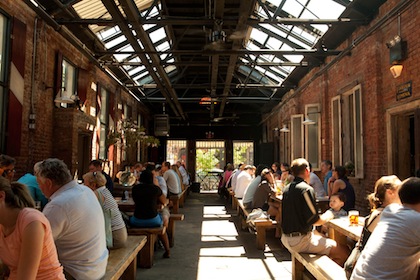Just out of the subway and trudging through freshly fallen snow, my sights were set on Radegast Hall and Biergarten in Brooklyn’s Williamsburg neighborhood. Fighting against a bracing wind, I focused on what I thought lay ahead of me: liters of lager brought to tables in bunches by—perhaps—a kind woman in a dirndl, in the corner an oompah band occasionally leading the crowd in song. Smiling as I opened the door with these thoughts, I was met with the sound of jazz.
Gemütlichkeit: (g-muet-lik-kite) a warm friendliness—belonging, social acceptance, cheerfulness, the absence of anything hectic...and the opportunity to spend quality time.
The band was playing a version of Cole Porter’s “Night and Day” and while quite good, it certainly wasn’t what I was expecting. A few moments later I settled into a stein of Weihenstephaner Dunkel Weiss and surveyed the scene. It was decidedly hipster, 30-somethings wearing T-shirts with ironic sayings or vague movie references. One was alone and reading with a glass of wine—yes, wine—in front of him. Two others were engrossed in the contents on the screen of a digital camera.

Brooklyn, NY's Radegast Hall (courtesy of Radegast Hall)
Clearly this was not Bavaria.
No, this was just one of many “beer gardens” that has sprang up in recent years around the country, making it seem that bar owners are embracing a new decorating theme much in the same way that “Irish pubs” were in fashion a decade ago.
And why not? Bavaria is the fertile crescent of beer. Hundreds of thousands of people make pilgrimages to Munich each year to drink deep from the kegs of some of the world’s best-known and beloved breweries. The styles developed over the centuries by master brewers have been enjoyed and imbibed by millions and copied and analyzed by fellow brewers around the globe. In short, so much of what people enjoy about beer found its beginnings in Germany.
Then consider how the United States is in the midst of a beer renaissance. Sure, sugary vodka-based drinks that masquerade as martinis are still popular at lounges and wine lists still rein supreme at high-end restaurants. But beer brings people together for a good time and rather than just another neighborhood dive, restaurateurs are capitalizing on the current beer trend and are offering up a place with an “authentic feel.”










